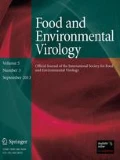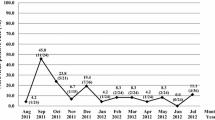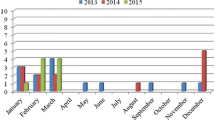Abstract
Shellfish complying with European Regulations based on quantification of fecal bacterial indicators (FIB) are introduced into markets; however, information on viruses, more stable than FIB, is not available in the literature. To assess the presence of noroviruses (NoVs) GI and GII and human adenoviruses (HAdV) in domestic and imported mussels and clams (n = 151) their presence was analyzed during winter seasons (2004–2008) in north-west Spanish markets through a routine surveillance system. All samples tested negative for NoV GI and 13 % were positive for NoV GII. The role of HAdV as viral indicator was evaluated in 20 negative and 10 positive NoV GII samples showing an estimated sensitivity and specificity of HAdV to predict the presence of NoV GII of 100 and 74 % (cut-off 0.5). The levels of HAdV and NoVs and the efficiency of decontamination in shellfish depuration plants (SDP) were evaluated analyzing pre- and post-depurated mussels collected in May–June 2010 from three different SDP. There were no statistically significant differences in the prevalence and quantification of HAdV between pre- and post-depurated shellfish and between seawater entering and leaving the depuration systems. Moreover, infectious HAdV were detected in depurated mussels. These results confirm previous studies showing that current controls and depuration treatments limiting the number of FIB do not guarantee the absence of viruses in shellfish.

Similar content being viewed by others
References
Bofill-Mas, S., Albinana-Gimenez, N., Clemente-Casares, P., Hundesa, A., Rodriguez-Manzano, J., Allard, A., et al. (2006). Quantification and stability of human adenoviruses and polyomavirus JCPyV in wastewater matrices. Applied and Environmental Microbiology, 72, 7894–7896.
Boxman, I. L., Tilburg, J. J., Te Loeke, N. A., Vennema, H., Jonker, K., de Boer, E., et al. (2006). Detection of noroviruses in shellfish in the Netherlands. International Journal of Food Microbiology, 108, 391–396.
Buesa, J., Collado, B., López-Andújar, P., Abu-Mallouh, R., Rodríguez Díaz, J., García Díaz, A., et al. (2002). Molecular epidemiology of caliciviruses causing outbreaks and sporadic cases of acute gastroenteritis in Spain. Journal of Clinical Microbiology, 40, 2854–2859.
Calgua, B., Barardi, C. R., Bofill-Mas, S., Rodriguez-Manzano, J., & Girones, R. (2011). Detection and quantitation of infectious human adenoviruses and JC polyomaviruses in water by immunofluorescence assay. Journal of Virological Methods, 171, 1–7.
Calgua, B., Mengewein, A., Grunert, A., Bofill-Mas, S., Clemente-Casares, P., Hundesa, A., et al. (2008). Development and application of a one-step low cost procedure to concentrate viruses from seawater samples. Journal of Virological Methods, 153(2), 79–83.
Chan, M. C., Sung, J. J., Lam, R. K., Chan, P. K., Lee, N. L., Lai, R. W., et al. (2006). Fecal viral load and norovirus-associated gastroenteritis. Emerging Infectious Diseases, 12, 1278–1280.
Cliver, D. O. (1997). Virus transmission via food. World Health Statistics Quarterly, 50, 90–101.
Corrêa, A. A., Albarnaz, J. D., Moresco, V., Poli, C. R., Teixeira, A. L., Simões, C. M. O., et al. (2007). Depuration dynamics of oysters (Crassostrea gigas) artificially contaminated by Salmonella enterica serovar Typhimurium. Marine Environmental Research, 63, 479–489.
Corrêa, A. A., Rigotto, C., Moresco, V., Kleeman, C. R., Teixeira, A. L., Poli, C. R., et al. (2012). The depuration dynamics of oysters (Crassostrea gigas) artificially contaminated with hepatitis A virus and human adenovirus. Memórias do Instituto Oswaldo Cruz, 107(1), 7–11.
Donovan, T. J., Gallacher, S., Andrews, N. J., Greenwood, M. H., Graham, J., Russell, J. E., et al. (1998). Modification of the standard method used in the United Kingdom for counting Escherichia coli in live bivalve molluscs. Communicable Disease and Public Health, 1, 188–196.
EPA. (1998). Drinking water contamination candidate list. Candidate List: Notice. Federal Register, 60, 10274–10287.
EU. (2004a). Commission regulation (EC) No 853/2004 of 29 April 2004 laying down specific hygiene rules for food of animal origin. Official Journal of the European Communities L, 139, 22–82.
EU. (2004b). Commission regulation (EC) No 854/2004 of 29 April 2004 laying down specific rules for the organization of official controls on products of animal origin intended for human consumption. Official Journal of the European Communities L, 139, 83–127.
EU. (2004c). Corrigendum to Regulation (EC) No 852/2004 of the European Parliament and of the Council of 29 April 2004 on the hygiene of foodstuffs. Official Journal of the European Communities L, 226, 3–21.
EU. (2008). Commission regulation (EC) No 1021/2008 of 17 October 2008 amending Annexes I, II and III to Regulation (EC) No 854/2004 laying down specific rules for the organization of official controls on products of animal origin intended for human consumption and regulation (EC) No 2076/2005 as regards live bivalve molluscs, certain fishery products and staff assisting with official controls in slaughterhouses. Official Journal L, 277, 15–17.
Formiga-Cruz, M., Allard, A. K., Conden-Hansson, A. C., Henshilwood, K., Hernroth, B. E., Jofre, J., et al. (2003). Evaluation of potential indicators of viral contamination in shellfish and their applicability to diverse geographical areas. Applied and Environmental Microbiology, 69, 1556–1563.
Formiga-Cruz, M., Tofiño-Quesada, G., Bofill-Mas, S., Lees, D. N., Henshilwood, K., Allard, A. K., et al. (2002). Distribution of human virus contamination in shellfish from different growing areas in Greece, Spain, Sweden, and the United Kingdom. Applied and Environmental Microbiology, 68, 5990–5998.
Gabrieli, R., Macaluso, A., Lanni, L., Saccares, S., Di Giamberardino, F., Cencioni, B., et al. (2007). Enteric viruses in molluscan shellfish. New Microbiologica, 30, 471–475.
Girones, R. (2006). Tracking viruses that contaminate environment. Journal of Environmental Engineering and Science, 1, 19–25.
Girones, R., & Bofill-Mas, S. (2013). Virus indicators for food and water. In Nigel Cook (Ed.), Chapter 26 in Viruses in food and water: Risks, surveillance and control. Cambridge, UK: Woodhead Publishing Ltd.
Girones, R., Ferrús, M. A., Alonso, J. L., Rodriguez-Manzano, J., Calgua, B., Corrêa, A. A., et al. (2010). Molecular detection of pathogens in water–the pros and cons of molecular techniques. Water Research, 44, 4325–4339.
Hernroth, B., & Allard, A. (2007). The persistence of infectious adenovirus (type 35) in mussels (Mytilus edulis) and oysters (Ostrea edulis). International Journal of Food Microbiology, 113, 296–302.
Hernroth, B. E., Conden-Hansson, A. C., Rehnstam-Holm, A. S., Girones, R., & Allard, A. K. (2002). Environmental factors influencing human viral pathogens and their potential indicator organisms in the blue mussel, Mytilus edulis: The first Scandinavian report. Applied and Environmental Microbiology, 68, 4523–4533.
Hundesa, A., Bofill-Mas, S., Maluquer de Motes, C., Rodriguez-Manzano, J., Bach, A., Casas, M., et al. (2010). Development of a quantitative PCR assay for the quantitation of bovine polyomavirus as a microbial source-tracking tool. Journal of Virological Methods, 163, 385–389.
Hundesa, A., Maluquer de Motes, C., Albinana-Gimenez, N., Rodriguez-Manzano, J., Bofill-Mas, S., Suñen, E., et al. (2009). Development of a qPCR assay for the quantification of porcine adenoviruses as an MST tool for swine fecal contamination in the environment. Journal of Virological Methods, 158, 130–135.
ISO. (2005). Microbiology of food and animal feeding stuffs. Horizontal method for the enumeration of beta-glucuronidase-positive Escherichia coli—Part 3: most probable number technique using 5-bromo-4-chloro-3-indolyl-beta- d -glucuronide. ISO 16649:2005. London: International Organisation for Standardisation.
Jackson, K. L. & Ogburn, D. M. (1999). Review of depuration and its role in shellfish quality assurance. NSW Fisheries Final Report Series No. 13. FRDC Project No. 96/355, pp. 77.
Jothikumar, N., Lowther, J. A., Henshilwood, K., Lees, D. N., Hill, V. R., & Vinjé, J. (2005). Rapid and sensitive detection of noroviruses by using TaqMan-based one-step reverse transcription-PCR assays and application to naturally contaminated shellfish samples. Applied and Environmental Microbiology, 71, 1870–1875.
Koopmans, M., Vinjé, J., Duizer, E., de Wit, M., & van Duijnhoven, Y. (2001). Molecular epidemiology of human enteric caliciviruses in The Netherlands. Novartis Foundation Symposium, 238, 197–214.
Le Guyader, F., Loisy, F., Atmar, R. L., Hutson, A. M., Estes, M. K., Ruvoen-Clouet, N., et al. (2006). Norwalk virus-specific binding to oyster digestive tissues. Emerging Infectious Diseases, 12, 931–936.
Lee, R., Lovatelli, A., & Ababouch, L. (2008). Bivalve depuration: Fundamental and practical aspects. FAO Fischeries Technical Paper No. 511. FAO, Rome, Italy. ftp://ftp.fao.org/docrep/fao/011/i0201e/i0201e.pdf.
Lees, D. (2000). Viruses and bivalve shellfish. International Journal of Food Microbiology, 59, 81–116.
Loisy, F., Atmar, R. L., Guillon, P., Le Cann, P., Pommepuy, M., & Le Guyader, F. S. (2005). Real-time RT-PCR for norovirus screening in shellfish. Journal of Virological Methods, 123, 1–7.
Love, D. C., Lovelace, G. L., & Sobsey, M. D. (2010). Removal of Escherichia coli, Enterococcus fecalis, coliphage MS2, poliovirus, and hepatitis A virus from oysters (Crassostrea virginica) and hard shell clams (Mercinaria mercinaria) by depuration. International Journal of Food Microbiology, 143, 211–217.
Matthews, J. E., Dickey, B. W., Miller, R. D., Felzer, J. R., Dawson, B. P., Lee, A. S., et al. (2012). The epidemiology of published norovirus outbreaks: A review of risk factors associated with attack rate and genogroup. Epidemiology and Infection, 140, 1161–1172.
Muniain-Mujika, I., Calvo, M., Lucena, F., & Girones, R. (2003). Comparative analysis of viral pathogens and potential indicators in shellfish. International Journal of Food Microbiology, 83, 75–85.
Muniain-Mujika, I., Girones, R., & Lucena, F. (2000). Viral contamination of shellfish: Evaluation of methods and analysis of bacteriophages and human viruses. Journal of Virological Methods, 89, 109–118.
Muniain-Mujika, I., Girones, R., Tofiño-Quesada, G., Calvo, M., & Lucena, F. (2002). Depuration dynamics of viruses in shellfish. International Journal of Food Microbiology, 77, 125–133.
Murchie, L. W., Cruz-Romero, M., Kerry, J. P., Linton, M., Patterson, M. F., Smiddy, M., et al. (2005). High pressure processing of shellfish: A review of microbiological and other quality aspects. Innovative Food Science and Emerging Technologies, 6, 257–270.
Myrmel, M., Berg, E. M., Rimstad, E., & Grinde, B. (2004). Detection of enteric viruses in shellfish from the Norwegian coast. Applied and Environmental Microbiology, 70, 2678–2684.
Nappier, S. P., Graczyk, T. K., & Schwab, K. J. (2008). Bioaccumulation, retention, and depuration of enteric viruses by Crassostrea virginica and Crassostrea ariakensis oysters. Applied and Environmental Microbiology, 74, 68225–68231.
Nappier, S. P., Graczyk, T. K., Tamang, L., & Schwab, K. J. (2010). Co-localized Crassostrea virginica and Crassostrea ariakensis oysters differ in bioaccumulation, retention and depuration of microbial indicators and human enteropathogens. Journal of Applied Microbioly, 108, 736–744.
National Center for Biotechnology Information (NCBI). (2013). Retrieved April 16, 2013 from http://blast.ncbi.nlm.nih.gov/Blast.cgi.
Nygård, K., Torvén, M., Ancker, C., Knauth, S. B., Hedlund, K. O., Giesecke, J., et al. (2003). Emerging genotype (GIGIIb) of norovirus in drinking water, Sweden. Emerging Infectious Diseases, 9, 1548–1552.
Pina, S., Puig, M., Lucena, F., Cofre, J., & Girones, R. (1998). Viral pollution in the environment and in shellfish: Human adenovirus detection by PCR as an index of human viruses. Applied and Environmental Microbiology, 64, 3376–3382.
Potasman, I., Paz, A., & Odeh, M. (2002). Infectious outbreaks associated with bivalve shellfish consumption: A worldwide perspective. Clinical Infectious Diseases, 35, 921–928.
Reuter, G., Krisztalovics, K., Vennema, H., Koopmans, M., & Szucs, G. (2005). Evidence of the etiological predominance of norovirus in gastroenteritis outbreaks–emerging new-variant and recombinant noroviruses in Hungary. Journal of Medical Virology, 76, 598–607.
Rodrick, G. E. & Schneider, K. R. (2003). Molluscan shellfish depuration. In: Villaboa, A., Reguera, B., Romalde, J., Reis, R., Proceedings of the 4th International Conference on Molluscan Shellfish Safety, Santiago de Compostela, Spain, 2002.
Rodríguez-Lázaro, D., Cook, N., Ruggeri, F. M., Sellwood, J., Nasser, A., Nascimento, M. S., et al. (2012). Virus hazards from food, water and other contaminated environments. FEMS Microbiology Reviews, 36, 786–814.
Romalde, J. L., Area, E., Sánchez, G., Ribao, C., Torrado, I., Abad, X., et al. (2002). Prevalence of enterovirus and hepatitis A virus in bivalve molluscs from Galicia (NW Spain): inadequacy of the EU standards of microbiological quality. International Journal of Food Microbiology, 74, 119–130.
Siebenga, J. J., Vennema, H., Zheng, D. P., Vinjé, J., Lee, B. E., Pang, X. L., et al. (2009). Norovirus illness is a global problem: Emergence and spread of norovirus GII.4 variants, 2001–2007. Journal of Infectious Diseases, 200, 802–812.
Thompson, J. D., Gibson, T. J., Plewniak, F., Jeanmougin, F., & HiGIns, D. G. (1997). The CLUSTAL_X windows interface: Flexible strategies for multiple sequence alignment aided by quality analysis tools. Nucleic Acids Research, 25, 4876–4882.
Tian, P., Bates, A. H., Jensen, H. M., & Mandrell, R. E. (2006). Norovirus binds to blood group A-like antigens in oyster gastrointestinal cells. Letters in Applied Microbiology, 43, 645–651.
Tuan Zainazor, C., Hidayah, M. S., Chai, L. C., Tunung, R., Ghazali, F. M., & Son, R. (2010). The scenario of norovirus contamination in food and food handlers. Journal of Microbiology and Biotechnology, 20, 229–237.
Ueki, Y., Shoji, M., Suto, A., Tanabe, T., Okimura, Y., Kikuchi, Y., et al. (2007). Persistence of caliciviruses in artificially contaminated oysters during depuration. Applied and Environmental Microbiology, 73, 5698–5701.
Vennema, H., de Bruin, E., & Koopmans, M. (2002). Rational optimization of generic primers used for Norwalk-like virus detection by reverse transcriptase polymerase chain reaction. Journal of Clinical Virology, 25, 233–235.
Verzani, J. (2004). Using R for Introductory Statistics. London: Chapman & Hall/CRC.
Acknowledgments
We thank the University of Barcelona’s Scientific and Technical Services for sequencing the PCR products. The research described in the manuscript was supported by grants from the “Ministerio de Educación y Ciencia” of the Spanish Government (Project AGL2008-05275-C03-01, AGL2011-30461-C02-01, and A/017172/08) and the European Commission Framework Program 7 project “Integrated monitoring and control of foodborne viruses in European food supply chains (VITAL)” (Grant No. KBBE 213178) led by the coordination team of Nigel Cook (FERA, UK), Martin D’Agostino (FERA, UK), and Franco M. Ruggeri (ISS, Italy). The work was also possible for the support and cooperation of the Health Protection Agency, Health Department, Generalitat de Catalunya. Anna Carratalà was a fellow of the Spanish Ministry of Science. We are grateful to Dr. D. Furones from the Centre d’Aquicultura, Institut de Recerca i Tecnologies Agroalimentaries (IRTA), San Carles de la Ràpita, Spain, for assistance during the sampling in the Ebro River Delta area. C.R.M. Barardi was a fellowship from CNPq, V. Moresco and A.P.D. Ramos received support from AECID, Spain.
Author information
Authors and Affiliations
Corresponding author
Rights and permissions
About this article
Cite this article
Rodriguez-Manzano, J., Hundesa, A., Calgua, B. et al. Adenovirus and Norovirus Contaminants in Commercially Distributed Shellfish. Food Environ Virol 6, 31–41 (2014). https://doi.org/10.1007/s12560-013-9133-1
Received:
Accepted:
Published:
Issue Date:
DOI: https://doi.org/10.1007/s12560-013-9133-1




